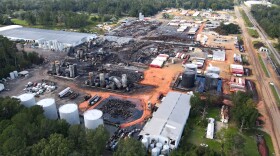-
The Gulf is one of the LAST places in the world where there is still a major wild oyster harvest. Lately, though, that harvest…is in trouble. In this episode, we ask: What can the oyster's downfall and resurrection tell us about a future of farming the ocean?
-
Part 1 of a 2-part series exploring the future of farming seafood in the Gulf. There’s a growing global movement to farm more and more of our seafood. Currently, proposals are being considered to establish massive fish farms in U.S. federal waters. The most likely first home to these new farms is the Gulf.
-
Ten people were arrested earlier this month for alleged immigration violations during a joint state and federal patrol of oyster beds in St. Bernard and Terrebonne parishes.
-
The smallest and most endangered of sea turtles, the Kemp's Ridleys, have returned to Louisiana's Chandeleur Islands after 75 years.
-
The climate talks — known as Conference of the Parties, or COP30 for this year’s edition — have long left Indigenous people out or relegated them to the sidelines.
-
A tool tracking billion dollar disasters is active again after being retired by Trump administrationLouisiana is in the top four, costing more than $300 billion since 1980.
-
The practice is called community, citizen or participatory science, and it involves data collected from non-scientists that’s passed along to researchers who use their expertise to study and understand what they mean
-
What does it take to stay rooted on the Gulf Coast, even as the land and weather change around us? We meet individuals, from a poet to a minister to a computer programmer, each finding their own creative ways to adapt and fight for the future of their communities.
-
Representatives for the locally-owned Smitty’s said the EPA and the LDEQ will still offer guidance as they resume control of the now charred and empty site.
-
A survivor tells his experience of being jailed in New Orleans during Hurricane Katrina, while officials and experts look at jails and natural disasters today.
-
For decades, the military treated climate change as a threat. Now it’s backing away from plans to protect people and bases from extreme weather.
-
The groups allege that the council violated Louisiana’s Open Meetings Law in a series of votes related to the expansion of an ammonia plant.
















